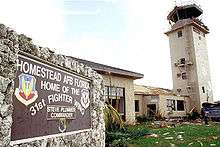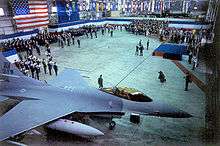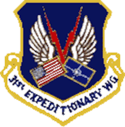Aviano Air Base
| Aviano Air Base | |
|---|---|
| Part of United States Air Forces in Europe (USAFE) | |
| Located near: Aviano, Friuli-Venezia Giulia, Italy | |
|
A 31st Fighter Wing F-16 Fighting Falcon at Aviano AB | |
| Coordinates | 46°01′53″N 012°35′49″E / 46.03139°N 12.59694°E |
| Site history | |
| Built | 1911 |
| In use | 1954–present |
| Garrison information | |
| Past commanders |
|
| Airfield information | |||||||||||
|---|---|---|---|---|---|---|---|---|---|---|---|
| Summary | |||||||||||
| Elevation AMSL | 410 ft / 125 m | ||||||||||
| Coordinates | 46°01′53″N 012°35′49″E / 46.03139°N 12.59694°ECoordinates: 46°01′53″N 012°35′49″E / 46.03139°N 12.59694°E | ||||||||||
| Website | www.aviano.af.mil | ||||||||||
| Map | |||||||||||
 LIPA Location of Aviano Air Base | |||||||||||
| Runways | |||||||||||
| |||||||||||
Aviano Air Base (IATA: AVB, ICAO: LIPA) (Italian: Base aerea di Aviano) is a NATO base in northeastern Italy, in the Friuli-Venezia Giulia region. It is located in the Aviano municipality, at the foot of the Carnic Pre-Alps, or Southern Carnic Alps, about 15 kilometers from Pordenone.
The Italian Air Force has ownership and administrative control of the base and hosts the U.S. Air Force's 31st Fighter Wing.
The 31st FW is the only U.S. fighter wing south of the Alps. This strategic location makes the wing critical to operations in NATO's southern region.[4] The 31st FW maintains two F-16 fighter squadrons, the 555th Fighter Squadron and the 510th FS, allowing the wing to conduct offense and defensive combat air operations.
History
Aviano Air Base was established by the Italian government in 1911, and was used as training base for Italian pilots and construction facility for aircraft parts. During World War I, Italy used the airfield in missions against the Austro-Hungarian and German armies. At that time, two Italian aviators, Captain Maurizio Pagliano and Lieutenant Luigi Gori, conducted an unauthorized, but heroic and successful, air raid on the Austrian naval yards in Pula, in what is now Croatia. In their honor, the base's name was officially changed to Aeroporto Pagliano e Gori, in 1919. During the war the airfield was also overrun by the Austro-German army in the months between November 1917 to November 1918. Between the two wars the airfield was again used as a training base.
During World War II, both the Italian Air Force and the German Luftwaffe flew missions from Aeroporto Pagliano e Gori. British forces captured the base in 1945; they conducted air operations there until 1947, when the Italian Air Force resumed operational use of the airport.
The 1976 earthquake caused no damage to settlement.
United States Air Force use
Units
The 31st Fighter Wing is made up of four groups, each consisting of several squadrons.
The 31st Operations Group ensures the combat readiness of two F-16CG squadrons, one air control squadron, and one operational support squadron conducting and supporting worldwide air operations. The group prepares fighter pilots, controllers, and support personnel to execute U.S. and NATO war plans and contingency operations. It trains, equips, plans, and provides weather, intelligence, standardization/evaluation, and command and control sustaining global flying operations.[5]
The 31st Maintenance Group provides peacetime and combat maintenance and munitions control, and executive support for the 31st Fighter Wing, geographically separated units under the command and control of the wing, and units gained during advanced stages of readiness. The 31st MXG also responds to humanitarian and contingency logistics support requirements as directed by the Joint Chiefs of Staff through Headquarters U.S. Air Forces Europe to locations in Europe, Africa, and Southwest Asia.[6]
The 31st Mission Support Group’s goal is to provide infrastructure and service to support a premiere combat capability and quality of life to the 31st Fighter Wing, Aviano community and multiple geographically separated units.[7]
The 31st Medical Group supports the readiness of 31st Fighter Wing and associated units throughout the Southern Region, ensuring the health of its community by providing optimal patient-focused medical care from internal, Department of Defense and Host Nation resources. The unit employs medical resources and preventive initiatives to ensure Airmen remain mission ready to support the Expeditionary Air Force, U.S. and NATO objectives worldwide.[8]
Hurricane Andrew and Balkan operations
As part of the most extensive restructuring since the Air Force became a separate service, the Tactical Air Command was inactivated and the Air Combat Command was activated and the 31st Tactical Fighter Wing was redesignated to its current name, the 31st Fighter Wing.[9]
On August 24, 1992, when Hurricane Andrew swept across southern Florida, leaving extensive damage in its wake. Every building of Homestead AFB received some damage, many buildings were destroyed.[10] The fighter squadrons evacuated most of the planes before the storm but were unable to return. In the aftermath, the secretary of defense recommended complete closure of the base, but in June 1993, the Base Realignment and Closure Commission recommended realigning the base under the Air Force Reserve and inactivating the 31st Fighter Wing. The squadrons were assigned to other wings and the 31st FW began inactivation proceedings.


To avoid losing the wing’s heritage and history as the highest scoring Army Air Force unit in the Mediterranean Theater in WWII, the impressive combat record in Vietnam and number of significant firsts they produced in the early years of the Air Force, the 31 FW was chosen to move rather than fade into obscurity. On April 1, 1994, the 31st Fighter Wing inactivated at Homestead AFB and subsequently activated at Aviano Air Base, Italy in place of the 401st Fighter Wing.[11]

The 31FW received two new squadrons at that time, the 555th and 510th Fighter Squadrons, along with their Block-40 F-16s. The wing immediately become involved with events in Bosnia, part of the former communist country of Yugoslavia, in May 1994 as part of Operation Deny Flight. In June 1995, a massive search and rescue operation took place to extract Capt. Scott O'Grady of the 555th FS who was shot down over Bosnian-Serb controlled territory in Bosnia. A U.S. Marine Corps CH-53 picked him up after he evaded capture for six days.[12]
In August and September, Operation Deliberate Force began and the 31st FW conducted air strikes against Bosnian Serbs conducting ethnic purges among the Muslim population of the country. Peacekeeping operations continued in the Balkans through the end of 2004, when the European Union assumed responsibility for the region.[13]


In 1999, U.S. Air Forces in Europe activated the 31st Air Expeditionary Wing-NOBLE ANVIL at Aviano for Operation Allied Force, the NATO operation to stop Serbian atrocities in the Province of Kosovo. Assigned under a joint task force, the 31st AEW, flew from Aviano and joined NATO allies in a 78-day air campaign against the Federal Republic of Yugoslavia (Serbia). From March 24 to June 10, 1999, the 31st AEW, the largest expeditionary wing in Air Force history flew nearly 9,000 combat sorties and accumulated almost 40,000 hours of combat service over the skies of Kosovo, Serbia and the rest of the Balkans in support of NATO operations. The wing accomplished much during OAF as the two permanently assigned flying squadrons, the 510th and 555th, flew more than 2,400 combined sorties and more than 10,000 combat hours.[14]
Operations in Iraq, Afghanistan and Libya
In 2000, the wing began deployments in support of the Expeditionary Air Force. From March to September 2000, the 510th and 555th Fighter Squadrons conducted back-to-back deployments to Ahmed Al Jaber AB, Kuwait, in support of Operation Southern Watch. While at Al Jaber, the squadrons flew more than 400 combat sorties.
From June through December 2001, the fighter squadrons deployed combat search and rescue capabilities three times and helped enforce the no fly zone over Iraq.
From August to December 2002, the 510th Fighter Squadron and 603rd Air Control Squadron returned to Southwest Asia. The two squadrons supported Operation Enduring Freedom.
Simultaneously, the 555th deployed personnel and aircraft to Decimomannu AB, Sardinia while the runway at Aviano closed for repairs.
The wing’s support of Operation Iraqi Freedom began in late 2003. Aviano served as the launch point for airborne/air-land insertion of airborne forces opening a second front in northern Iraq. During that time, the wing secured, bedded and fed more than 2,300 Army and Air Force personnel. The operation, the largest airborne operation since 1989, constituted 62 missions, transporting 2,146 passengers and 2,433.7 tons of cargo.
Since the beginning of combat operations in Iraq, forces from the wing have been on regular combat rotations into the region. In late 2003, the wing’s 603rd Air Control Squadron became the first unit from the wing to deploy to Iraq. They also relocated their entire operation from Baghdad International Airport to Balad AB. Under combat conditions, the squadron transferred $73 million in equipment and more than 100 personnel with 20 convoys. On April 10, 2004, insurgents launched a mortar attack on Balad, killing Airman 1st Class Antoine Holt and injuring two other 603rd ACS members. Airman Holt’s death constituted the 31st FW’s first combat fatality since the Vietnam War.
The 31st Fighter Wing continued deploying forces in support of OIF and OEF, with more than one-third of the wing deploying to support operations each year from 2003 to 2007.
In 2007, the 555th FS deployed to Kunsan AB, Republic of Korea.
Since arriving at Aviano, the wing has also participated in numerous training exercises with international partners, including training deployments to Latvia, the Czech Republic, Romania, Bulgaria, Spain, Slovenia and Poland.
In March 2011, the 31st FW played a major role in the United Nations' response to the crisis in Libya, known as Operation Odyssey Dawn, in enforcing no-fly zone UNSR 1973. The wing hosted four flying units and more than 1,350 personnel during the 15-day operation, March 17–31. It worked around the clock to launch 2,250 flying operations out of Aviano AB. As OOD came to an end on March 31, so began Operation Unified Protector, with NATO taking the lead until the operation's conclusion Oct. 31 of that year.[11]
Aviano F-16's again returned to the skies over Libya in June 2014. Due to significant fighting in Tripoli during the 2014 Libyan conflict the U.S Embassy was evacuated. During a five-hour NEO, three F-16's launched from Aviano guarded the evacuation of American citizens as Embassy Staff and U.S Marines convoyed overland from Tripoli into Tunisia.[15][16][17]
Cavalese cable-car disaster
In the Cavalese cable car disaster, on February 3, 1998, a U.S. Marine Corps jet flying too low on a training exercise from Aviano Air Base severed a cable car's cable over the Alps at Cavalese, Italy, causing 20 deaths.[18]
Imam rapito affair
On November 4, 2009, the conviction by an Italian court of 22 CIA agents, a U.S. Air Force colonel and two Italian SISMI secret agents confirmed the role of the Aviano Air Base in the kidnapping, on February 17, 2003, of Hassan Mustafa Osama Nasr, in the so-called "extraordinary rendition" program.[19] The man, abducted in Milan by CIA agents, was taken to Aviano Air Base for interrogation before being transported via Ramstein Air Base (Germany) to Alexandria, Egypt, and turned over to the custody of Egypt's State Security Intelligence[19][20][21]
Layout
- Area A1 contains a few of Aviano's support functions (such as the library and chapel) and the Department of Defense Dependents School for the base population's children.
- Area A2 contains a fitness center, dining facility, dormitories, thrift shop and a fire department.
- Area C contains most of the 31st Civil Engineer Squadron's facilities.
- Area D contains a soccer field and picnic area.
- Area E contains AFN, military working dog kennels and Air Force Office of Special Investigations detachment. The Italian Carabinieri (military police) also have their base headquarters in this area.
- Area F is the flightline area, and is the largest area in Aviano. The complex contains the active runway and taxiways and most of the base's facilities.
See also
- Cavalese cable car disaster (1998)
- United States Air Forces in Europe
- Imam rapito affair
 Aviation portal
Aviation portal- List of airports in Italy
References
- ↑ Aviano Air Base, official site
- ↑ Airport information for LIPA from DAFIF (effective October 2006)
- ↑ Airport information for AVB at Great Circle Mapper. Source: DAFIF (effective October 2006).
- ↑ "31st Fighter Wing Fact Sheet". Archived from the original on 31 October 2013. Retrieved 2 July 2013.
- ↑ "31st Operations Group Fact Sheet". Archived from the original on 30 December 2013. Retrieved 2 July 2013.
- ↑ "31st Maintenance Group Fact Sheet". Archived from the original on 31 December 2013. Retrieved 2 July 2013.
- ↑ "31st Mission Support Group Fact Sheet". Archived from the original on 30 December 2013. Retrieved 2 July 2013.
- ↑ "31st Medical Group Fact Sheet". Archived from the original on 30 December 2013. Retrieved 2 July 2013.
- ↑ "31st Fighter Wing (USAFE)". Air Force Historical Research Agency. Archived from the original on 28 September 2015. Retrieved 2 July 2013.
- ↑ Allen, Greg (August 23, 2012). "Hurricane Andrew's Legacy: 'Like A Bomb' In Florida". www.npr.org. Retrieved 2 July 2013.
- 1 2 "A HISTORY OF THE 31ST FIGHTER WING" (pdf). 31st FW Historian. Retrieved 2 July 2013.
- ↑ Fedarko, Kevin (June 19, 1995). "RESCUING SCOTT O'GRADY: ALL FOR ONE". Time Magazine. Retrieved 2 July 2013.
- ↑ "Operation Deliberate Force: Ten years on". NATO. Retrieved 2 July 2013.
- ↑ "OPERATION ALLIED FORCE". Air Force Historical Studies Office. Retrieved 2 July 2013.
- ↑ http://www.dailymail.co.uk/news/article-2707429/US-evacuates-embassy-Libya-heavy-military-protection.html
- ↑ http://theaviationist.com/2014/07/27/ep-3e-during-emb-evacuation/
- ↑ http://www.militarytimes.com/article/20140726/NEWS08/307260049/New-details-emerge-Libya-embassy-evacuation
- ↑ Kozaren, Lynda (March 16, 1998). "Investigators Blame Marines for Cable Car Accident". www.defense.gov. Archived from the original on 2012-07-14.
- 1 2 "CIA agents guilty of Italy kidnap". BBC News. 4 November 2009.
- ↑ "Italians held over 'CIA kidnap'". BBC News. 5 July 2006.
- ↑ Paolo Biondani (24 June 2005). "I pm di Milano: arrestate gli agenti della Cia" [Milan's prosecutors:"Arrest CIA agents"]. Corriere della Sera (in Italian).
Some of this text in an early version of this article was taken from pages on the Aviano Air Base website, which as a work of the U.S. Government is presumed to be a public domain resource. That information was supplemented by:
- Donald, David (2004) Century Jets: USAF Frontline Fighters of the Cold War. AIRtime ISBN 1-880588-68-4
- Endicott, Judy G. (1999) Active Air Force wings as of 1 October 1995; USAF active flying, space, and missile squadrons as of 1 October 1995. Maxwell AFB, Alabama: Office of Air Force History. CD-ROM.
- Fletcher, Harry R. (1989) Air Force Bases Volume II, Active Air Force Bases outside the United States of America on 17 September 1982. Maxwell AFB, Alabama: Office of Air Force History. ISBN 0-912799-53-6
- Martin, Patrick (1994). Tail Code: The Complete History of USAF Tactical Aircraft Tail Code Markings. Schiffer Military Aviation History. ISBN 0-88740-513-4.
- Ravenstein, Charles A. (1984). Air Force Combat Wings Lineage and Honors Histories 1947-1977. Maxwell AFB, Alabama: Office of Air Force History. ISBN 0-912799-12-9.
- Rogers, Brian (2005). United States Air Force Unit Designations Since 1978. Hinkley, England: Midland Publications. ISBN 1-85780-197-0.
- USAAS-USAAC-USAAF-USAF Aircraft Serial Numbers--1908 to present
External links
| Wikimedia Commons has media related to Aviano Air Base. |
- SETAF and United States Army Africa Official Website
- Aviano Air Base, official site
- Aviano Air Base at GlobalSecurity.org
- Aviano Blog (Blog about stores, restaurants, and events in the area of Aviano AB)
